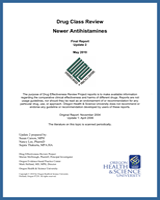NCBI Bookshelf. A service of the National Library of Medicine, National Institutes of Health.
This publication is provided for historical reference only and the information may be out of date.
Antihistamines inhibit the effects of histamine at H1 receptors. They have a number of clinical indications including allergic conditions (e.g., rhinitis, dermatoses, atopic dermatitis, contact dermatitis, allergic conjunctivitis, hypersensitivity reactions to drugs, mild transfusion reactions, and urticaria), chronic idiopathic urticaria (CIU), motion sickness, vertigo, and insomnia.
First-generation antihistamines are highly lipophilic and therefore readily cross the blood-brain barrier, contributing to adverse central nervous system effects, including sedation, drowsiness, and decreased cognitive processing.
Newer antihistamines were developed to decrease the adverse effects of first generation drug. "Second generation" antihistamines have higher specificity for binding to H1 receptors, lower affinity for non-histamine receptors, and are lipo-phobic (thus have poor penetration of the blood brain barrier). Third generation antihistamines are natural metabolites of first generation drugs, developed with the goal of improving clinical efficacy and minimizing side-effects. The purpose of this review was to compare the efficacy, effectiveness, and adverse effects of newer antihistamines in both adult and pediatric populations.
Contents
- Introduction
- Methods
- Results
- Overview
- Key Question 1. For outpatients with seasonal or perennial allergic rhinitis or urticaria, do newer antihistamines differ in effectiveness?
- Key Question 2. For outpatients with seasonal or perennial allergic rhinitis or urticaria, do newer antihistamines differ in harms?
- Key Question 3. Are there subgroups of patients based on demographics (age, racial groups, gender), concomitant medications (drug-drug interactions), co-morbidities (drug-disease interactions or pregnancy), for which one newer antihistamine is more effective or associated with fewer harms?
- Summary of the Evidence
- References
- Appendix A Glossary
- Appendix B Search strategy for Update 2
- Appendix C Methods used to assess quality of studies
- Appendix D Excluded studies in Update 2
- Appendix E Reporting of adverse events
- Appendix F Poor-quality studies
- Evidence Tables
Original Report: November 2004
Update 1: April 2006
The medical literature relating to this topic is scanned periodically. (See http://www.ohsu.edu/ohsuedu/research/policycenter/DERP/about/methods.cfm for description of scanning process). Prior versions of this report can be accessed at the DERP website.
Drug Effectiveness Review Project
Marian McDonagh, PharmD, Principal Investigator
Oregon Evidence-based Practice Center
Mark Helfand, MD, MPH, Director
Oregon Health & Science University
The Drug Effectiveness Review Project, composed of 12 organizations including 11 state Medicaid agencies and the Canadian Agency for Drugs and Technology in Health commissioned and funded for this report. These organizations selected the topic of the report and had input into its Key Questions. The content and conclusions of the report were entirely determined by the Evidence-based Practice Center researchers. The authors of this report have no financial interest in any company that makes or distributes the products reviewed in this report.
Suggested citation:
Carson S, Lee N, Thakurta S. Drug class review: Newer antihistamines. Update 2.
The purpose of Drug Effectiveness Review Project reports is to make available information regarding the comparative clinical effectiveness and harms of different drugs. Reports are not usage guidelines, nor should they be read as an endorsement of or recommendation for any particular drug, use, or approach. Oregon Health & Science University does not recommend or endorse any guideline or recommendation developed by users of these reports.
- Review Drug Class Review: Newer Antihistamines: Final Report[ 2006]Review Drug Class Review: Newer Antihistamines: Final ReportOregon Evidence-based Practice Center. 2006 Apr
- Review Treatment for allergic rhinitis and chronic idiopathic urticaria: focus on oral antihistamines.[Ann Pharmacother. 2005]Review Treatment for allergic rhinitis and chronic idiopathic urticaria: focus on oral antihistamines.Morgan MM, Khan DA, Nathan RA. Ann Pharmacother. 2005 Dec; 39(12):2056-64. Epub 2005 Nov 8.
- Review Efficacy and safety of H1-antihistamines: an update.[Antiinflamm Antiallergy Agents...]Review Efficacy and safety of H1-antihistamines: an update.Kalpaklioglu F, Baccioglu A. Antiinflamm Antiallergy Agents Med Chem. 2012; 11(3):230-7.
- Review Antihistamines.[LiverTox: Clinical and Researc...]Review Antihistamines.. LiverTox: Clinical and Research Information on Drug-Induced Liver Injury. 2012
- Review CSACI position statement: Newer generation H(1)-antihistamines are safer than first-generation H(1)-antihistamines and should be the first-line antihistamines for the treatment of allergic rhinitis and urticaria.[Allergy Asthma Clin Immunol. 2...]Review CSACI position statement: Newer generation H(1)-antihistamines are safer than first-generation H(1)-antihistamines and should be the first-line antihistamines for the treatment of allergic rhinitis and urticaria.Fein MN, Fischer DA, O'Keefe AW, Sussman GL. Allergy Asthma Clin Immunol. 2019; 15:61. Epub 2019 Oct 1.
- Drug Class Review: Newer AntihistaminesDrug Class Review: Newer Antihistamines
- Pangio borneensis[orgn] (0)Genome
Your browsing activity is empty.
Activity recording is turned off.
See more...
